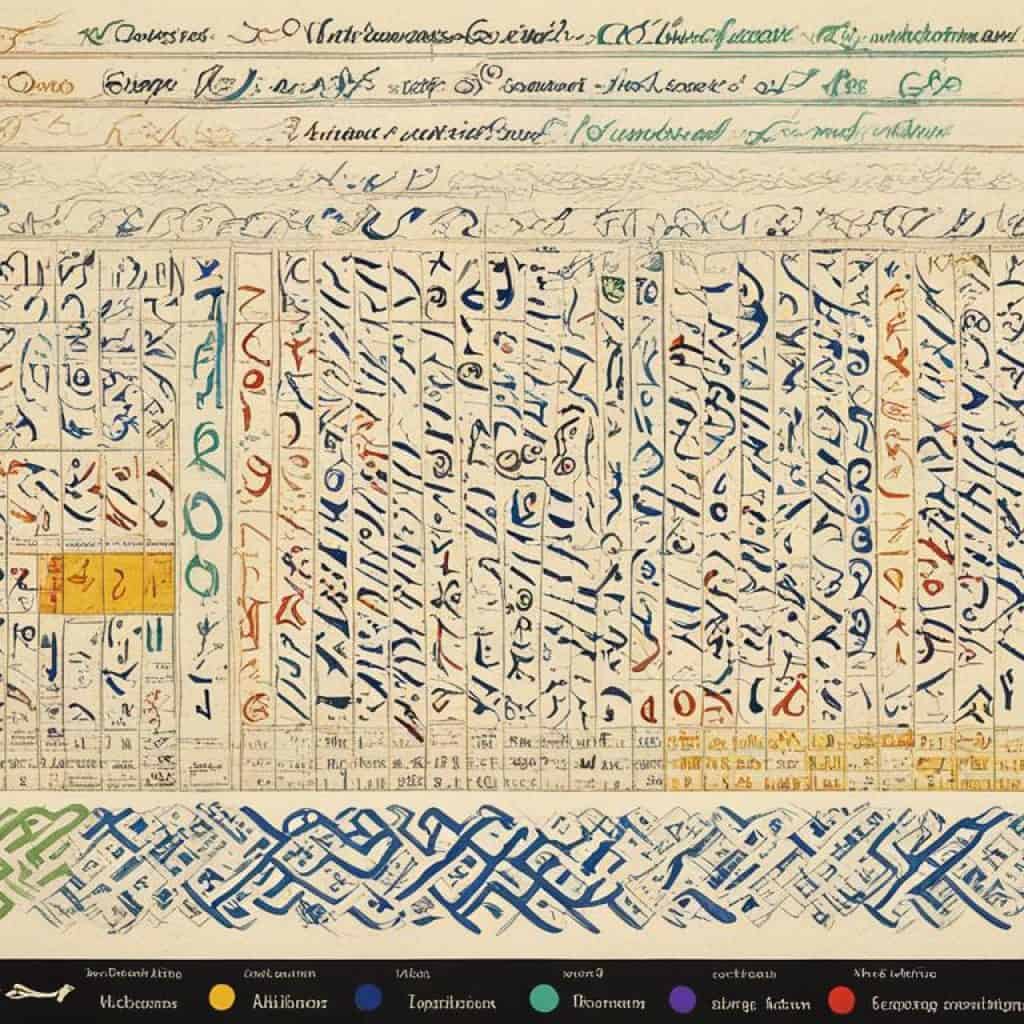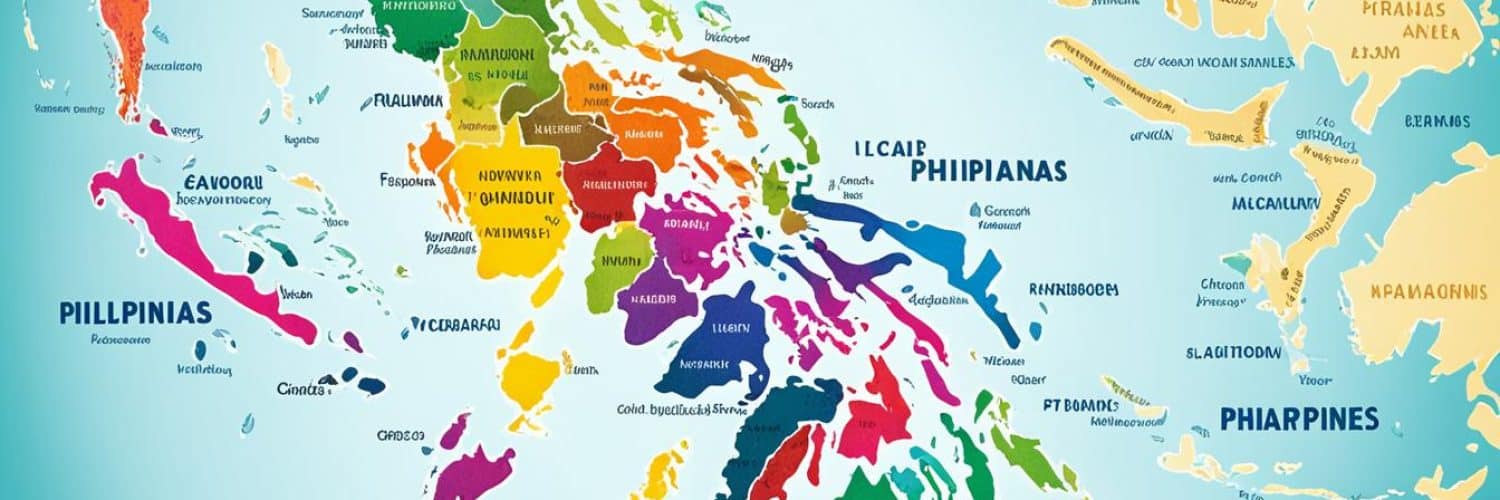Did you know the Philippines is a treasure trove of languages? It has everything from Filipino to local dialects and native languages. This nation in Southeast Asia is rich in linguistic variety. Let’s explore the broad spectrum of languages spoken in the Philippines, their roots, and why they matter.
Key Takeaways:
- The Philippines is a linguistically diverse country with over 120 to 175 languages spoken.
- Major languages spoken in the Philippines include Filipino, English, and regional languages like Waray-Waray, Kinaray-a, Kapampangan, Ilokano, Hiligaynon, and Cebuano.
- The linguistic landscape of the Philippines is influenced by its history of colonization and the rich cultural heritage of its indigenous communities.
- Efforts to preserve and revitalize indigenous languages are ongoing to safeguard the country’s linguistic diversity and cultural heritage.
- Filipino, the national language, incorporates vocabulary from native languages to promote inclusivity and national unity.
The Historical Background of the Philippines
The Philippines has a rich history full of cultural and language influences. It’s been shaped by years of colonization and indigenous cultures. To truly understand the country, we must know its history. This shapes its complex culture and diverse languages.
Spanish Colonization: Shaping the Linguistic Landscape
In the 16th century, Spain colonized the Philippines. This era deeply influenced the country. Spanish became the main language for government, education, and religion. Filipinos started using Spanish words in their languages. This left a strong mark on their linguistic identity.
“Spanish colonization introduced the Philippines to a new language, which became deeply ingrained within the linguistic fabric of the country.”
American Colonial Rule: The Rise of English
Late in the 19th century, the Philippines was under American rule. The Americans made English the instruction language in schools. Over time, English became more important than Spanish. It was seen as a sign of progress.
“Under American colonial rule, English gained prominence, transforming the linguistic landscape of the Philippines once again.”
Filipino Identity and Cultural Diversity
The Philippines became independent in 1946. They started to shape their national identity. In 1939, Tagalog was made the official language, which evolved into Filipino. Filipino has elements from various Philippine languages. It shows a commitment to include all languages and recognize the country’s diverse heritage.
A Tapestry of Linguistic Diversity
The history of the Philippines has created a country with many languages. Besides Filipino, languages like Cebuano, Ilocano, Hiligaynon, and more are spoken widely. This variety of languages shows the rich culture and resilience of its people.
Preserving Cultural Heritage
The Philippines works hard to keep its cultural and linguistic heritage alive. There are efforts to document and promote indigenous languages. This ensures future generations can enjoy their traditional languages and cultural roots.
Cultural Diversity and National Unity
The variety of languages in the Philippines brings its people together, rather than dividing them. It encourages cultural understanding and strengthens national unity. The Philippines is a prime example of the value of diversity and preserving cultural heritage.
Official Language of Philippines
In 1939, the Philippines made Tagalog its official language. Later, it evolved into Filipino. This marked a key move towards including all and building a common identity. The 1987 constitution strengthened Filipino’s place as the national language. It recognized its role in bringing people together and preserving culture.
The Evolution from Tagalog to Filipino
Switching from Tagalog to Filipino involved big changes. Tagalog was mainly spoken in Manila and nearby. It laid the groundwork for Filipino. Adding words from other local languages made Filipino richer. It became a language that shows the nation’s diverse culture.
“The recognition of Filipino as the national language shows the Philippines’ dedication to welcoming all languages and celebrating its varied culture.”
Today, the Philippines officially uses both Filipino and English. Adding English reflects the American influence from history. This choice is key for education, government, business, and trade.
Constitutional Changes and Linguistic Unity
Naming Filipino as the national language was a big step. It was about unity and welcoming all. Filipino, rich in words from many local languages, connects diverse groups. It helps everyone understand each other and feel part of one nation.
The country honors both Filipino and English as official languages. This respects their significance and the Philippines’ diverse background. It encourages clear communication and cultural sharing.
The Role of Language in Cultural Heritage
The national language is key in keeping and sharing the Philippines’ culture. Filipino, with elements from many local languages, showcases the country’s rich diversity. It promotes wide appreciation and unity.
Championing Filipino as the national language underlines a commitment to welcoming all languages. It protects the cultural history. It ensures that many local languages grow with the national language. Together, they add to the country’s rich language scene.
Official Languages in the Philippines
| Language | Status |
|---|---|
| Filipino | Official and national language |
| English | Official language |
Native Languages of the Philippines
The Philippines is known for its many languages. Over 134 ethnic groups have their own native languages. These languages do more than let people talk to each other. They also keep cultural stories, traditions, and ways of life alive.
Some of the main languages include Tagalog, Cebuano, Ilocano, Waray-Waray, and Bikol. Tagalog is mainly spoken in Manila and nearby areas. Cebuano is used in the Visayas and Mindanao. Ilocano is common in northern Luzon. Waray-Waray is spoken in Eastern Visayas, and Bikol is used in the Bicol region.
The variety of languages shows the rich culture and history of the Philippines. Each language reflects the identity of its ethnic group. These languages help keep ancient wisdom, stories, and diverse cultures alive.
There are efforts to protect and revive these languages. Cultural groups, schools, and local communities work together. They create language resources, run preservation programs, and include native languages in education. These actions preserve cultural heritage and help young people value their linguistic heritage.
Major Native Languages of the Philippines
| Language | Region |
|---|---|
| Tagalog | Manila and surrounding areas |
| Cebuano | Visayas and Mindanao |
| Ilocano | Northern Luzon |
| Waray-Waray | Eastern Visayas |
| Bikol | Bicol region |
These languages showcase the linguistic diversity of the Philippines. They reflect the many cultures and ethnic groups of the islands. They also help people feel they belong and keep unique traditions alive. While Filipino is the national language, honoring native languages is key to preserving cultural heritage and promoting inclusivity.
“Language is the key to unlock the door of cultural understanding and appreciation. Through embracing native languages, we unveil the richness of our heritage and honor the legacy of our ancestors.” – Unknown
Filipino – The National Language
Filipino, the national language of the Philippines, plays a vital role in unity and heritage. It is a symbol of identity and belonging for the country’s diverse linguistic communities.
Based on Tagalog, it includes words from other native languages. This shows the country’s effort to celebrate all its languages. It enriches the nation’s linguistic diversity.
Filipino is more than just a way to talk to each other. It brings people together and promotes national identity. It helps Filipinos from different areas understand and express themselves.
“Filipino serves as a bridge, connecting people from different provinces and ethnic backgrounds. It allows us to celebrate our linguistic diversity while fostering a sense of national pride and unity.” – Maria Cruz, Filipino language scholar
The growth of Filipino as a national language highlights the Philippines’ focus on inclusivity. It acknowledges the importance of cultural heritage. By including words from various languages, Filipino respects the Filipino people’s rich culture.

Through Filipino, the Philippines aims to keep its cultural heritage alive. The language is a way to pass down traditions and values to future generations.
Besides, Filipino promotes unity by connecting different linguistic communities. It lets Filipinos from all backgrounds communicate and understand each other. This creates respect and value for diversity in society.
The Significance of Linguistic Unity
Linguistic unity is key in building a nation. It gives a shared identity and purpose. Through the national language, Filipinos can talk, collaborate, and work towards shared goals.
While English is also important, promoting Filipino strengthens bonds among Filipinos. It highlights their collective cultural identity.
In conclusion, Filipino as the national language symbolizes a diverse nation’s unity. It includes elements from many languages, showing respect for Filipino heritage. This shared language promotes national identity and cultural unity.
The Most Spoken Languages of the Philippines
In the Philippines, many languages show the country’s rich history and culture. Filipino is the national language. But English, from American rule, is also key in education and business.
Spanish has influenced the Philippines even though it’s less spoken now. Many Spanish words are part of Filipino languages. This shows in Filipino culture today.
English and Filipino are top languages in the Philippines. People often use English in offices, schools, and businesses. It’s a main way to communicate.
“English is everywhere in the Philippines. Schools teach it, businesses use it, and it helps connect different areas.”
The Philippines loves its languages and cultures. The mix of Filipino, English, and Spanish shows how it welcomes different influences.
Language Influences in the Philippines
Many factors have shaped Philippine languages. Spanish rule brought Spanish language and changed Filipino languages. Also, trade with countries like China affected the Philippine languages.
The Philippine languages show a great history and people’s efforts to keep their culture. Documenting and saving native languages help protect the Philippines’ diverse culture.
| Language | Main Usage |
|---|---|
| Filipino | National language, used in formal settings and media |
| English | Widely spoken, used in education, business, and government |
| Spanish | Historical influence, integrated into Filipino languages |
Efforts to Preserve and Revitalize Philippines Native Languages
The Philippines is known for its rich cultural heritage. This includes a vast array of native languages. The government has put in place laws and programs to protect and revive these languages.
This work helps keep the unique identities and traditions of each language alive. It’s vital for the future.
Many groups work together in this mission. They include organizations, schools, and local communities. They make learning materials like dictionaries, guides, and more. These help in keeping languages alive.
These projects make a space where native languages are valued and celebrated. They help maintain linguistic diversity. They also protect our cultural history.
“Language is more than a means of communication; it is the vessel that carries the essence of a culture, identity, and heritage. By preserving and revitalizing native languages, we are ensuring the survival of our cultural tapestry—the very thing that makes us who we are.”
A key effort is the Mother Tongue-Based Multilingual Education (MTB-MLE) policy. This makes native languages a core part of education. It’s used in schools across the country. It helps students understand and appreciate their culture better.
Indigenous communities are also deeply involved. They hold festivals, workshops, and events that celebrate their languages. This includes storytelling, poetry, and music. These activities help pass languages from one generation to the next.
Protecting language diversity and reviving native ones is key to keeping the Philippines’ culture alive. It connects future generations to their heritage. This strengthens their sense of identity.
Challenges in Filipino Native Language Preservation
The Philippines faces hard times keeping native languages alive. This is due to globalization, growing cities, and fewer people speaking these languages. Losing these languages could harm the country’s rich culture and heritage.
Globalization Impact
Globalization brings the world closer. But, it makes Filipino youth lean towards global cultures and languages. They see foreign languages as more useful. This might make them use traditional languages less.
Urbanization
In big cities like Manila, native languages are fading fast. People move to cities for jobs and speak mostly Tagalog there. This can make local languages disappear over time.
Preservation Efforts
“Keeping our native languages alive is key. It protects our culture and helps us stay connected to our roots.” – Cultural Preservation Organization
People are working hard to save these languages. The government, nonprofits, and schools are helping. They make learning resources and programs to keep languages alive.
Language Decline
The use of native languages is dropping fast. If young people don’t learn these languages, they might get lost. We need to act now to keep the Philippines’ languages and culture strong.
| Preservation Challenges | Impact |
|---|---|
| Globalization | Decreased usage and preference for cosmopolitan languages |
| Urbanization | Diminished daily use of native languages in urban centers |
| Language Decline | Potential loss of linguistic diversity and cultural heritage |
We need to do more to keep Filipino languages alive. Teaching these languages in schools, media, and daily life is important. This will help protect the country’s diverse culture and languages.
History of Language in the Philippines
The story of language in the Philippines is rich and long. Before colonizers came, the islands had many unique languages. These languages showed the culture of each region and group.
Colonization changed the Philippines’ languages a lot. Spanish rule, starting in the 16th century, made Spanish very important. It was used in government, trade, religion, and schools. Today, some Philippine languages still show Spanish influence.

Cultural Exchange and Trade Interactions
The Philippines was a busy trade spot in Southeast Asia. This trading led to adding words from other languages to many Philippine languages. Words from Malay, Chinese, and Sanskrit got mixed in, showing the area’s trade history.
“Trade interactions with neighboring countries influenced the adoption of vocabulary and linguistic features from other languages.”
The Role of American Colonial Rule
American rule started in 1898, after Spain. Then, English became very important. It was taught in schools and used in government and business.
This American influence added English words to Philippine languages. This created a mix of Philippine and English language features.
Language Evolution and Cultural Identity
Philippine languages tell the story of the nation’s rich culture. They have changed through colonization, trade, and American rule. These changes created a special mix of languages.
Now, these languages show the pride of the Philippines. They reflect its culture and diversity. Efforts are being made to keep native languages alive for future generations.
Tagalog vs Filipino Language: What Is the Difference?
Many people get Tagalog and Filipino mixed up. Although they are related, they have their own unique traits. They come from the same roots but are different.
Tagalog is spoken mainly in Manila and nearby places. It’s a key language in the Philippines. It helped form Filipino, the nation’s language.
Filipino, however, is the Philippines’ official language. It’s rooted in Tagalog. Filipino was made to unite various ethnic groups in the country. It includes words from many languages, adding to its richness.
Linguistic Similarities
Tagalog and Filipino are quite alike and easy to understand for speakers of both. They have the same grammar and basic words. So, people who speak one can usually understand the other.
Since Tagalog is the base for Filipino, the latter also includes words from other languages. This makes both languages inclusive. It helps Filipinos communicate well, no matter their regional language.
Language Evolution and National Language Development
Creating Filipino as the national language was a big step. It includes words from many native languages. This shows the diversity and history of the Filipino people.
The goal was to connect different ethnic groups. Filipino helps build national unity and pride. It celebrates the Philippines’ many languages.
“Filipino incorporates vocabulary from various native languages, allowing other linguistic communities to contribute to its development and representation.”
Tagalog vs Filipino Language
| Tagalog | Filipino |
|---|---|
| Native language spoken in Manila and surrounding areas | National language of the Philippines |
| Regional in nature | Representative of the entire country |
| Shares linguistic roots with Filipino | Based on Tagalog and incorporates vocabulary from other native languages |
| May exhibit minor regional variations in vocabulary and pronunciation | Exists as a standardized form |
It’s key to see how Tagalog and Filipino connect and enhance the Philippines’ languages. Both are crucial for embracing the country’s cultural diversity. They help Filipinos communicate effectively.
Other Languages of the Philippines
Tagalog and Filipino are well-known in the Philippines, but they’re not the only languages. The country enjoys a wide range of languages. This includes Cebuano, Ilocano, and Hiligaynon, among others.
Cebuano, also called Bisaya, is mainly spoken in the Central Visayas and Mindanao. It’s the second most spoken language in the country. Its unique vocabulary and grammar set it apart.
Ilocano is mainly spoken in the Luzon’s Ilocos region. It ranks as the third most spoken language. Ilocano is celebrated for its rich literature and poetic flair.
Hiligaynon, or Ilonggo, is the language of the Western Visayas region. It’s known for its melodic quality. This makes it popular for songs and poetry.
These languages, with Tagalog and Filipino, highlight the Philippines’ linguistic richness. Each language tells the story of its region’s culture and heritage.
The effects of Spanish and English on the Philippine languages are significant. Spanish has influenced with many loanwords, although it’s not widely spoken. English, however, is used in education, business, and everyday communication. This reflects the American colonial past and global connections.
The variety of languages in the Philippines shows its rich culture. It also shows how different language communities live together in harmony.
Is There Still an Official Language of the Philippines Today?
Filipino and English are the Philippines’ official languages. Filipino is the national language. English is used in schools, government, and business. This shows the importance of both languages in the country.
The Linguistic Status of the Philippines
The Philippines values its language variety. Filipino and English are both important in society.
Filipino, also known as Tagalog, is the national language. It’s mainly used in Manila. Filipino unites the country’s many language groups.
English is everywhere in the Philippines. It’s essential for jobs and communicating globally. People value English for better job chances.
Filipino Language Recognition
The 1987 Philippine Constitution highlights the importance of language and culture. It made Filipino the national language (Article XIV, Section 6).
Filipino brings people together and celebrates the nation’s culture. The country aims to be inclusive and keep its language heritage alive.
English is still widely used in education and media. It adds to the bilingual nature of Filipino society.
The Role of English in the Philippines
English has been important in the Philippines since American rule. It was the language of schools and government.
Now, many Filipinos speak English. It helps with education and jobs, both locally and abroad. English is key in many industries.
English adds to the national language. It highlights the Philippines’ global openness and the need for English worldwide.
The Future of Language in the Philippines
The country is proud of its linguistic diversity. Filipino and English show the nation’s complex language situation. Being multilingual is crucial today.
There’s a push to keep native languages alive. Through projects and programs, languages are being documented and taught. This honors their cultural importance.
The Philippines’ languages are changing with the world. Filipino and English are official, but local languages remain vital. This reflects the nation’s rich culture and language inclusivity.
| Official Languages of the Philippines | Linguistic Status | Filipino Language Recognition |
|---|---|---|
| Filipino | Recognized as the national and official language of the Philippines. | Protected and promoted through the 1987 Philippine Constitution; celebrates the language and culture of the Filipino people. |
| English | Widely used in education, government affairs, business, and trade. | Highly valued for economic advancement and international communication. |
With Filipino as the national language and English’s key role, the Philippines celebrates language diversity and unity.
Conclusion
The Philippines is rich in languages, with over 120 to 175 spoken across the islands. This includes the national language, Filipino, and many indigenous languages. It shows the country’s cultural heritage and brings people together.
To keep this heritage alive, the Philippines has laws and programs. These efforts help save native languages. They keep traditional stories and customs alive. This helps maintain the Philippines’ diverse culture.
Valuing many languages brings unity to the Philippines. It shows the country cares about its culture. By promoting these languages, the Philippines connects its people and shares its cultural wealth with the world.







Add comment